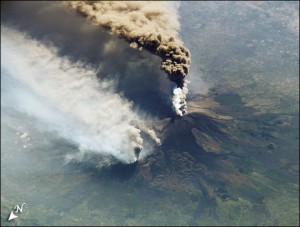16 December 2010
Hot lava on the move? Maybe not…
Posted by mohi

Are the early seismic signals thought to herald impending volcanic activity really what we think they are? Photo of erupting Mount Etna courtesy of NASA/ISS
Seismic waves emanating from a volcano may be an ominous sign that hot lava is on the move.
But then again, maybe not.
Inside a volcano, gases that move through rock fractures cause seismic rumbles and bumps even when lava is not making its way towards the crater above. Bits of rock vibrate as they crack, crush, and grind within the fracture system, always moving, albeit in geological super-slow-motion.
Seismic signals resonating from a subterranean pipes system gushing with hot lava should be very different from the signals generated by crushing rock. And they are–but only if you are recording the event close enough to the source. From far away, the signals appear very similar, and one can be easily confused for the other.
Chris Bean of the University of Ulster in Northern Ireland suspected something was up when he and his team ran numerical simulations of volcanic seismic events and found what he calls, “spurious” results. Seismic recordings from several active volcanoes did not match up to the seismic waves predicted by “currently accepted conduit resonance models.”
Think of “conduit resonance” as the seismic waves coming from lava surging and vibrating through a underground pipes to the mouth of the volcano.
The dissonance was enough to inspire a trip to Mount Etna on the beautiful Mediterranean island of Sicily. Bean and company placed 32 seismic recording stations on and around the volcano–all within a 2 kilometer radius and captured two seismic events while they were there.
They found that recordings taken near the source of activity were very different from recordings taken more than 200 meters away from the source. From a distance, the seismic waves appeared to come from a gigantic resonating pipe surging with hot lava. But recordings from closer to the source did not look that way at all. Rather, seismic waves recorded close to the source looked like waves they expect to see pulsing away from crushing bits of rock within branched fracture formations inside the volcano’s mound.
As he explained in his talk today, V32B-01: Long Period seismic events without conduit resonance: Implications for near surface fluid transport models on volcanoes, Bean set up instruments much closer to the seismic source than what is typically done. And that makes all the difference. The seismic signature changes significantly as it moves through the various materials of the volcano and the surrounding Earth–signals can interfere with each other, either canceling each other out or amplifying their peaks and troughs. This interference disguises what is happening in the volcano. Bean says you have to get within 200 meters of the source to really hear what’s going on.
–Donna Hesterman is a science communication graduate student at UC Santa Cruz










 GeoSpace is a blog on Earth and space science, managed by AGU’s Public Information staff. The blog features posts by AGU writers and guest contributors on all sorts of relevant science topics, but with a focus on new research and geo and space sciences-related stories that are currently in the news.
GeoSpace is a blog on Earth and space science, managed by AGU’s Public Information staff. The blog features posts by AGU writers and guest contributors on all sorts of relevant science topics, but with a focus on new research and geo and space sciences-related stories that are currently in the news.